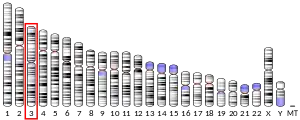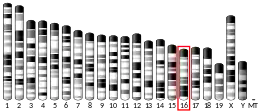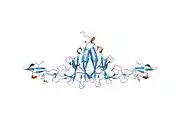BTLA
B- and T-lymphocyte attenuator is a protein that in humans is encoded by the BTLA gene.[5][6] BTLA has also been designated as CD272 (cluster of differentiation 272).
| BTLA | |||||||||||||||||||||||||
|---|---|---|---|---|---|---|---|---|---|---|---|---|---|---|---|---|---|---|---|---|---|---|---|---|---|
 | |||||||||||||||||||||||||
| |||||||||||||||||||||||||
| Identifiers | |||||||||||||||||||||||||
| Aliases | BTLA, BTLA1, CD272, B and T lymphocyte associated | ||||||||||||||||||||||||
| External IDs | OMIM: 607925 MGI: 2658978 HomoloGene: 52233 GeneCards: BTLA | ||||||||||||||||||||||||
| |||||||||||||||||||||||||
| |||||||||||||||||||||||||
| |||||||||||||||||||||||||
| Orthologs | |||||||||||||||||||||||||
| Species | Human | Mouse | |||||||||||||||||||||||
| Entrez | |||||||||||||||||||||||||
| Ensembl | |||||||||||||||||||||||||
| UniProt | |||||||||||||||||||||||||
| RefSeq (mRNA) | |||||||||||||||||||||||||
| RefSeq (protein) | |||||||||||||||||||||||||
| Location (UCSC) | Chr 3: 112.46 – 112.5 Mb | Chr 16: 45.22 – 45.26 Mb | |||||||||||||||||||||||
| PubMed search | [3] | [4] | |||||||||||||||||||||||
| Wikidata | |||||||||||||||||||||||||
| |||||||||||||||||||||||||
Function
BTLA expression is induced during activation of T cells, and BTLA remains expressed on Th1 cells but not Th2 cells. Like PD1 and CTLA4, BTLA interacts with a B7 homolog, B7H4.[6] However, unlike PD-1 and CTLA-4, BTLA displays T-Cell inhibition via interaction with tumor necrosis family receptors (TNF-R), not just the B7 family of cell surface receptors. BTLA is a ligand for tumour necrosis factor (receptor) superfamily, member 14 (TNFRSF14), also known as herpes virus entry mediator (HVEM). BTLA-HVEM complexes negatively regulate T-cell immune responses.
Clinical significance
BTLA activation inhibits the function of human CD8+ cancer-specific T cells.[7]
References
- GRCh38: Ensembl release 89: ENSG00000186265 - Ensembl, May 2017
- GRCm38: Ensembl release 89: ENSMUSG00000052013 - Ensembl, May 2017
- "Human PubMed Reference:". National Center for Biotechnology Information, U.S. National Library of Medicine.
- "Mouse PubMed Reference:". National Center for Biotechnology Information, U.S. National Library of Medicine.
- Watanabe N, Gavrieli M, Sedy JR, Yang J, Fallarino F, Loftin SK, Hurchla MA, Zimmerman N, Sim J, Zang X, Murphy TL, Russell JH, Allison JP, Murphy KM (July 2003). "BTLA is a lymphocyte inhibitory receptor with similarities to CTLA-4 and PD-1". Nature Immunology. 4 (7): 670–9. doi:10.1038/ni944. PMID 12796776. S2CID 11943145.
- "Entrez Gene: BTLA B and T lymphocyte associated".
- Derré L, Rivals JP, Jandus C, Pastor S, Rimoldi D, Romero P, Michielin O, Olive D, Speiser DE (January 2010). "BTLA mediates inhibition of human tumor-specific CD8+ T cells that can be partially reversed by vaccination". The Journal of Clinical Investigation. 120 (1): 157–67. doi:10.1172/JCI40070. PMC 2799219. PMID 20038811. Lay summary – Genetic Engineering & Biotechnology News.
Further reading
- Pao LI, Bedzyk WD, Persin C, Cambier JC (February 1997). "Molecular targets of CD45 in B cell antigen receptor signal transduction". Journal of Immunology. 158 (3): 1116–24. PMID 9013950.
- Pao LI, Cambier JC (March 1997). "Syk, but not Lyn, recruitment to B cell antigen receptor and activation following stimulation of CD45- B cells". Journal of Immunology. 158 (6): 2663–9. PMID 9058799.
- Vilen BJ, Famiglietti SJ, Carbone AM, Kay BK, Cambier JC (July 1997). "B cell antigen receptor desensitization: disruption of receptor coupling to tyrosine kinase activation". Journal of Immunology. 159 (1): 231–43. PMC 3931421. PMID 9200459.
- Gavrieli M, Watanabe N, Loftin SK, Murphy TL, Murphy KM (December 2003). "Characterization of phosphotyrosine binding motifs in the cytoplasmic domain of B and T lymphocyte attenuator required for association with protein tyrosine phosphatases SHP-1 and SHP-2". Biochemical and Biophysical Research Communications. 312 (4): 1236–43. doi:10.1016/j.bbrc.2003.11.070. PMID 14652006.
- Sedy JR, Gavrieli M, Potter KG, Hurchla MA, Lindsley RC, Hildner K, Scheu S, Pfeffer K, Ware CF, Murphy TL, Murphy KM (January 2005). "B and T lymphocyte attenuator regulates T cell activation through interaction with herpesvirus entry mediator". Nature Immunology. 6 (1): 90–8. doi:10.1038/ni1144. PMID 15568026. S2CID 23871512.
- Gonzalez LC, Loyet KM, Calemine-Fenaux J, Chauhan V, Wranik B, Ouyang W, Eaton DL (January 2005). "A coreceptor interaction between the CD28 and TNF receptor family members B and T lymphocyte attenuator and herpesvirus entry mediator". Proceedings of the National Academy of Sciences of the United States of America. 102 (4): 1116–21. Bibcode:2005PNAS..102.1116G. doi:10.1073/pnas.0409071102. PMC 544343. PMID 15647361.
- Cheung TC, Humphreys IR, Potter KG, Norris PS, Shumway HM, Tran BR, Patterson G, Jean-Jacques R, Yoon M, Spear PG, Murphy KM, Lurain NS, Benedict CA, Ware CF (September 2005). "Evolutionarily divergent herpesviruses modulate T cell activation by targeting the herpesvirus entry mediator cosignaling pathway". Proceedings of the National Academy of Sciences of the United States of America. 102 (37): 13218–23. Bibcode:2005PNAS..10213218C. doi:10.1073/pnas.0506172102. PMC 1201609. PMID 16131544.
- Compaan DM, Gonzalez LC, Tom I, Loyet KM, Eaton D, Hymowitz SG (November 2005). "Attenuating lymphocyte activity: the crystal structure of the BTLA-HVEM complex". The Journal of Biological Chemistry. 280 (47): 39553–61. doi:10.1074/jbc.M507629200. PMID 16169851.
- Otsuki N, Kamimura Y, Hashiguchi M, Azuma M (June 2006). "Expression and function of the B and T lymphocyte attenuator (BTLA/CD272) on human T cells". Biochemical and Biophysical Research Communications. 344 (4): 1121–7. doi:10.1016/j.bbrc.2006.03.242. PMID 16643847.
- Wang XF, Chen YJ, Wang Q, Ge Y, Dai Q, Yang KF, Zhou YH, Hu YM, Mao YX, Zhang XG (February 2007). "Distinct expression and inhibitory function of B and T lymphocyte attenuator on human T cells". Tissue Antigens. 69 (2): 145–53. doi:10.1111/j.1399-0039.2006.00710.x. PMID 17257317.
External links
- BTLA+protein,+human at the US National Library of Medicine Medical Subject Headings (MeSH)
- Human BTLA genome location and BTLA gene details page in the UCSC Genome Browser.
- Overview of all the structural information available in the PDB for UniProt: Q7Z6A9 (B- and T-lymphocyte attenuator) at the PDBe-KB.
This article incorporates text from the United States National Library of Medicine, which is in the public domain.




